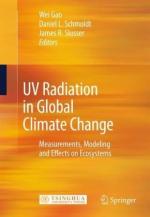|
This section contains 318 words (approx. 2 pages at 300 words per page) |
Ultraviolet (UV) radiation is a form of electromagnetic radiation that lies between visible light and x rays in its energy and wavelength. It is a component of the radiation that reaches the Earth from the sun. The broad UV band, having wavelengths between 190 nanometers (nm) and 400 nm, is conventionally divided into three parts: UV-A or near-UV (315 to 400 nm), UVB or mid-UV (280 to 315 nm), and UV-C or far-UV (190 to 280 nm). Much of the incident solar UV radiation is absorbed by gases in the earth's atmosphere and never reaches the earth's surface. This is fortunate, because UV radiation can chemically alter important biological molecules, including proteins and deoxyribonucleic acid (DNA), and thereby cause damage to living systems. The most familiar effect on humans is sunburn, which is the manifestation of UV's damage to outer skin cells. Long-term effects of excessive UV exposure include skin cancer, eye damage (cataracts), and suppression of the immune system.
Among the atmospheric gases that are the major absorbers of UV radiation is ozone (O3), which lies predominantly in the upper atmospheric region known as the stratosphere. Stratospheric ozone is particularly important in absorbing UV-B radiation. A current environmental issue concerns the depletion of stratospheric ozone (the ozone layer) by human-made chemicals such as chlorofluorocarbons (CFCs) and halons. With even small percentages of ozone depletion, more UV-B radiation reaches the surface of the earth and the harmful effects of UV increase.
Bibliography
World Meteorological Organization. (2003). Scientific Assessment of Ozone Depletion: 2002. Global Ozone Research and Monitoring Project, Report No. 47. Geneva: Author.
Internet Resource
NASA Advanced Supercomputing Division Web site. "Ultraviolet Radiation." Available from http://www.nas.nasa.gov/About/Education /Ozone/radiation.html.
United Nations Environment Programme. (1998). "Environmental Effects of Ozone Depletion 1998 Assessment." In the Global Change Research Information Office Web site. Available from http://www.gcrio.org/ozone/toc.html.
World Meteorological Organization. "UV Radiation Page." Available from http://www.srrb.noaa.gov/UV.
|
This section contains 318 words (approx. 2 pages at 300 words per page) |


